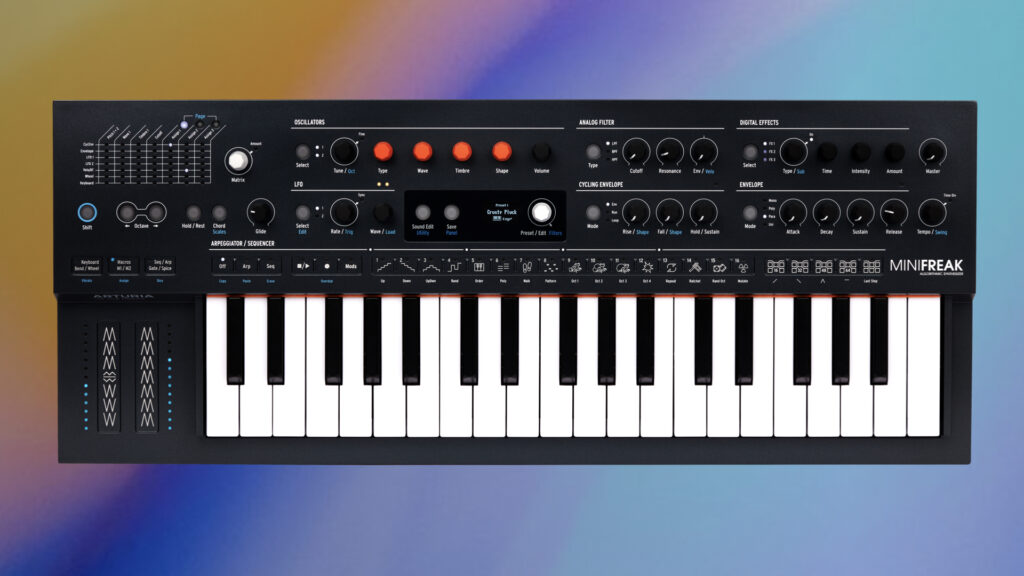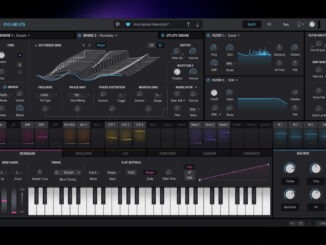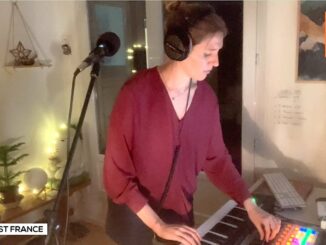Arturia MiniFreak, the MicroFreak hybrid Synthesizer expanded in the polyphonic realm with 6-voices, two oscillators, multi-fx, and more.
Many synthesizers have come onto the market in recent years. Analog as well as digital. The trend in recent years has been toward hybrid designs, where the features of both worlds are merged into new types of instruments. The Arturia MicroFreak, a multi-engine paraphonic hybrid Synthesizer, has done this very successfully.
Shortly after its release in 2019, there were community calls for a polyphonic, i.e. a Polyfreak. It has now taken 3+ years to make that wish come true. Not PolyFreak, but the MiniFreak brings you into the polyphonic freak world.
Arturia MiniFreak
Yes, it is real Arturia today announced the MiniFreak, the polyphonic brother/sister of the best-selling MicroFreak.
One thing ahead: at the time of writing this news article I don’t have a MinikFreak test unit. They are sent relatively late. Some YouTubers media got their units last week, some are getting them this week. Mine arrives tonight during the day. So I haven’t really gotten to know in real the new polysynth from Arturia yet.
At first glance, the design catches the eye. Significantly larger but it has a nice-looking slim, industrial design probably designed by Axel Hartmann. Also different: no more touch keyboard. Instead, it has a 37-note velocity-sensitive slim-key keybed with aftertouch. I’m assuming it’s mono-channel aftertouch and not polyphonic. The pitch and mod wheels on the left side are again fully implemented in digital form. It’s exciting with the engine which is different but not unfamiliar.
Deep Digital Oscillator And Analog Filter Relationship
The MicroFreak has four voices and is paraphonic. The MiniFreak, on the other hand, has 6 voices that work in true polyphony. Starting with the oscillators. The MiniFreak has 2 super rich multi-engine oscillators powered by 20+ algorithms.
They cover different synthesis types, including virtual analog, FM, additive, karplus-strong, and more. With the current firmware, you get the same algorithms as in the MicroFreak with even the same parameters: type, wave, timbre, and shape. Ok wait a little update: the wavetable and vocoder algorithms are missing. New additions are the tuning and the volume knob that sets the volume for each oscillator.
But that’s not all. First, you can unlock FM and RM on oscillator 2 for achieving even deeper timbres. Secondly, you can turn both oscillators into audio processors. More precisely, you can route external audio through oscillator 1 and deform it with folding, decimate, and noise. While oscillator 2 can be flipped into an effect processor into which oscillator 1 can be routed.
Available are different digital filters (multimode, Surgeon, Comb, Phaser) and a destroy processor that extremely mangles your signals using folding, decimate, and bit crushing. Then, both signals run into an Oberheim SEM-style state variable analog filter with cutoff and resonance controls. It is powered by six internal analog filters, which give you a true polyphonic playing experience.
Final Touch
In addition to the 6 analog filters, the MiniFreak also has an analog VCA per voice. And connected directly to this is a new 3-slot multi-effects section. One of the missing features of the MicroFreak. According to Arturia, the effects algorithms come from their flagship analog polysynth PolyBrute. Including chorus, phaser, flanger, reverb, delay, distortion, bit-crusher, 3-band EQ, peak EQ, and multi-comp.
Exciting each effect has various sub-types, each with a different character. For example, there are long, hall, echoes, and room reverbs, and for the chorus default, lush, dark, shaded, and single. Each effect slot has a limited set of controls and can be set to insert or send mode.
Modulation
A modulation engine should not be missing. This is strongly reminiscent of the MicroFreak mod engine, but has been massively expanded in places. This is managed again via mod matrix on the left side with various mod sources and destinations. On the source side, you get two envelopes per voice (1 classic + 1 cycling envelope), two LFOs per voice, keyboard (velocity/aftertouch) + touch strips as well as the arpeggiator and sequencer.
A special highlight is the expanded LFO section. In addition to classic and somewhat wilder waveforms, the MiniFreak has an integrated LFO shaper that you can use to draw your own waveforms (2 storable). This way you can generate very complex LFO modulations.
Arpeggiator & Sequencer
The arpeggiator and sequencer in the MicroFreak are particularly creative and inspiring. This can also be found in the new MiniFreak. It offers a 64-step sequencer (4 pages of 16 steps) with the option to create 4 lanes of parameter animation/modulation. Plus, you get a creative arpeggiator with ratcheting, octave randomization, and more.
Micro To Mini I/O
Connectivity also got a “pump up” from Micro to Mini. On the backside, you find a 12V power supply input with a switch, a headphone jack, a stereo output (L/R), and an audio input. There is also MIDI In/Out/Thru on classic big jacks, USB connectivity only for data, a sustain pedal input, and external hardware connectivity. Including clock in, clock out, and reset out.
The MiniFreak is operated via knobs, a relatively small OLED display, and touch buttons, which also represent the sequencer. It ships with 256 factory presets and you can save 256 user sounds giving you in total space for 512 sounds.
One More Thing… MiniFreak VST
Arturia also thought of all musicians who don’t work 100% DAWless. The MiniFreak will include a digital counterpart called MiniFreak V. A Synthesizer plugin that gives you the same features and sounds only in all-digital for the PC and Mac at no extra cost. Not official but think the MiniFreak V is also an editor for the hardware.
More Videos
First Impression
Now that was a wild range of features. The MicroFreak is already a fascinating hardware Synthesizer that never gets boring, at least for me. The micro fun put on steroids and in full polyphony. This is how you can describe the MiniFreak. The feature set promises a lot of sound design fun for a very long time. I’m looking forward to the first sounds. An in-depth review will follow in the coming weeks.
Arturia MiniFreak is available now for pre-order for 599€/$599 USD. Shipping starts in 3-4 weeks.
More information here: Arturia
You can support the SYNTH ANATOMY website by pre-order it at my partners









So many of these YouTube “influencers” just say how great everywthing is – so long as they’ve got it for free. I’d rather watch someone who paid their own money for it.
To be honest we live in times where we get very, very good synthesizers all the time. I have to think hard when we got a really bad synth, um I think the Akai Timbre Wolf. What should the bad synthfluencers to say? How bad it is or? Just because they get gear for free doesn’t mean they talk only good things. My review will also contain criticism but I’ll take my time for it.
And don’t forget there is hard work behind Video Creation. It takes hours to test, it takes time to record, you have to cut the video, you’ve put enough money into the video equipment… and to get to the point of Arturia sending the gear is hard work. That’s not 1 week’s work, it’s several years where you get nothing and just put money and time into it to raise your channel. Many forget that and only see the good point of video creation.
I agree with all that. But I have worked professionally as a reviewer myself in another area of the music industry. I know how it works. If a reviewer says too many bad things then they simply never get sent anything again.
This is not criticism directed to you. But *some* YouTube channels are simply gear grifters and manufacturers are very happy to work with them for mutual benefit.
It’s simple: it’s business and it’s how it works. I’m often excluded by big brands because I’m often too honest. But the good thing is: you can choose what do you want to see and easily ignore the channels you don’t want to see.
You seem terribly defensive for a general statement that was not necessarily directed at you, and more pointedly, just because you spent time, resources, and energy to create and promote your channel, it does not mean it absolves you and your reviews of some editorial oversight (the viewers) and your own integrity!
To simply say “that’s how it works” is neither an excuse or a reasonable explanation to play by the rules of manufacturers! The more seasoned and well established and even credible ‘content’ providers will be able to secure products for review so as long as they are honest with their first and true customers: the viewers.
never trust only one source of information. its the responsibility of any user to collect data by himself on as much sources as possible, not running into the shop of youtube and buying everything youtubers are telling you. im not running in any real shop expecting the sellsman to tell me the whole shebang. thats why people left that system long ago and now buy online or in shop pnly after they got as much info as possible. and hteres is no such thing as ONE PERFECT source opf information. thats kindergarten thinking.
Seems dope and that’s a good price.
Very interesting synth, but in the price range is stiff competition. Modal Cobalt 5s, ASM Hydrasynth Explorer with Polyaftertouch Minikeyboard, Waldorf Blofeld, Novation Mininova, Korg Minilogue XD…all no slouches either.
The bundled VST is very smart though. I am looking forward to your full review.